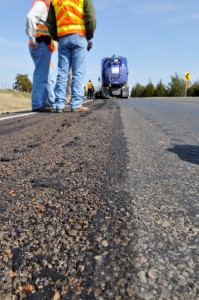Description
The Materials and Pavements (M&P) Division conducts a coordinated and extensive program of research to design, develop, and evaluate new pavement materials, techniques, equipment, and test procedures. Research focuses on improving the durability, safety, and efficiency of pavement materials and structures within both economic and environmental constraints.
Research units in the Materials and Pavements Division include:
- Flexible Pavements,
- Pavement Management,
- Pavement Materials Chemistry,
- Recyclable Materials, and
- Rigid Pavements.
Expertise
The M&P Division includes professionals from academic backgrounds such as civil, electrical, and chemical engineering, computer science, and soil and rock science. Of the 26 researchers in this division, 8 have joint appointments with the Department of Civil and Environmental Engineering and one has a joint appointment with the Department of Chemical Engineering. These professionals have extensive expertise in areas such as:
- physical and chemical characteristics of asphalt, Portland cement, and aggregates;
- flexible and rigid pavement design, construction, maintenance, and life-cycle cost analysis;
- computer modeling software design and development;
- digital image processing, pattern recognition, and signal processing;
- ground penetrating radar and other non-destructive testing techniques for pavements;
- pavement management systems;
- fracture mechanics;
- soil mechanics and dynamics;
- air transportation pavements and airport technology;
- material recycling/waste utilization; and
- development of training materials and coordinating training schools.
Recognized both nationally and internationally for their expertise, division researchers frequently present lectures and training sessions on their studies throughout North and South America, Europe, Asia, Africa, and Australia.
Research Initiatives
A wealth of expertise and resources, combined with state-of-the-art research tools, are all part of studies looking into areas such as rigid pavements, flexible pavements, pavement materials chemistry, and pavement management. In addition, the division’s recyclable materials group investigates methods to utilize industrial byproducts in paving mixtures, and ways to recycle reclaimed pavement materials.
Research Results
Researchers in the M&P Division are leaders in finding practical solutions to industry problems. For example, division researchers:
- first documented the natural ability of asphalt to self-mend fractures and recommended methods to maximize the healing process;
- developed methods to use fly ash in asphalt paving, roofing, and other construction materials, creating new markets for these byproducts;
- developed more accurate techniques for predicting pavement performance through test procedures utilizing the falling weight deflectometer (FWD);
- developed state-of-the-art image analysis techniques to measure shape, angularity, and surface texture of aggregates, enabling engineers to produce improved pavement mixtures;
- developed methods using ground penetrating radar (GPR) for highway departments to measure thickness and evaluate the condition of pavement layers beneath the surface;
- developed a method using a bank of infrared sensors for evaluating pavement quality (e.g., compaction quality and segregation) during construction;
- developed simple stepwise procedures for identifying and quantifying sulfate-bearing salts in subgrade soils;
- greatly advanced the use of surface energy measurements of asphalts and aggregates for predicting probability of moisture sensitivity and, more importantly, for designing asphalt mixtures immune to moisture damage; and
- prepared field guidelines for incorporating waste roofing materials into asphalt paving mixtures, use of recycled asphalt pavement in maintenance activities, selection of maintenance repair methods on expansive subgrades, micro-surfacing design and construction, and using geosynthetics with hot-mix asphalt overlays to reduce reflection cracking.
The Texas Department of Transportation (TxDOT) has implemented field and laboratory test procedures and design/construction guidelines and rewritten construction specifications based on researcher recommendations to improve quality control during design and construction of pavements.
Cooperative Relationships/Sponsors
In addition to the vast capabilities at TTI and Texas A&M University, researchers draw on the resources of several national and international centers located in the M&P Division. Established through partnerships with private industry and other institutions, these centers focus on specific issues in the areas of materials and pavements. These include the International Center for Aggregates Research, the Superpave Center, the Center for Infrastructure Engineering, and the Center for Asphalt and Materials Chemistry.
This division has forged long-term partnerships with other agencies, bringing millions of dollars to TTI and valuable research findings to the paving industry. Partnering with Western Research Institute has resulted in a major complementary research program to advance the fundamental knowledge of asphalt materials.
The division has a strong working relationship with and conducts research for the Texas Department of Transportation (TxDOT), as well as other state highway agencies. Additionally, private industry, municipalities, foundations, the National Cooperative Highway Research Program (NCHRP), the National Academy of Sciences, the U.S. Department of Transportation, and other federal agencies are research sponsors. The M&P Division routinely works with TTI’s Constructed Facilities Division to accomplish research projects.
This division vigorously supports academic goals by typically employing 30 graduate students and 10 undergraduate students.

